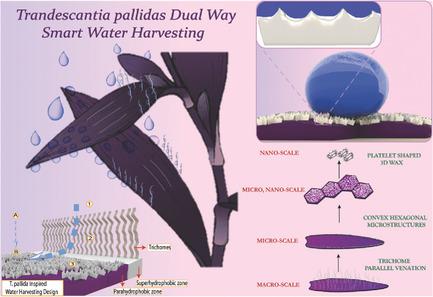当前位置:
X-MOL 学术
›
Adv. Mater. Interfaces
›
论文详情
Our official English website, www.x-mol.net, welcomes your
feedback! (Note: you will need to create a separate account there.)
Characterization and Bioreplication of Tradescantia pallida Inspired Biomimetic Superwettability for Dual Way Patterned Water Harvesting
Advanced Materials Interfaces ( IF 4.3 ) Pub Date : 2018-07-15 , DOI: 10.1002/admi.201800723 Neha Suvindran 1 , Feiran Li 1 , Yunlu Pan 1 , Xuezeng Zhao 1
Advanced Materials Interfaces ( IF 4.3 ) Pub Date : 2018-07-15 , DOI: 10.1002/admi.201800723 Neha Suvindran 1 , Feiran Li 1 , Yunlu Pan 1 , Xuezeng Zhao 1
Affiliation

|
Biomimicry elucidates nature's faultless synchronization of structure with function inspiring researchers to create designs that can achieve maximum performance with minimalistic resource exhaustion. Nature has evolved the invasive species Tradescantia pallida (T. pallida) with the ability to survive in drought lands. Since this species requires humidity to survive in those conditions it can be inferred that the T. pallida partakes of foliar atmospheric water harvesting. Herein, the wettability is tested with the study establishing that the leaf exhibits para‐hydrophobicity while demonstrating a static contact angle of 165°, whereas the morphological characterization reveals a complex hierarchical sculpturing with macroscale trichomes and parallel venations. Moreover, it is identified that the foliar water uptake occurs via the para‐hydrophobic surface and the hydrophobic trichomes subsequently guiding the water along the parallel channels creating a leaf that has an efficient dual way water harvesting system. These features render it capable of surviving in any habitat that validates nature's perfect unification of structure and function. Such multifunctional surfaces are a rarity thereby making them desirable for smart water harvesting designs. Thus inspired, a replica is developed which mimics the wettability with functional artificial trichomes and a potential dual way patterned water harvesting concept is presented.
中文翻译:

拟南芥启发的仿生超湿性的表征和生物复制,用于双路模式集水
仿生学阐明了自然界无可挑剔的结构与功能的同步性,激发了研究人员创造出能够以最小的资源消耗实现最高性能的设计。大自然已经进化出能够在干旱土地上生存的入侵物种Tradescantia pallida(T. pallida)。由于该物种需要湿度才能在这些条件下生存,因此可以推断出T. pallida收集叶面大气水。在本文中,通过研究确定了叶片的亲疏水性,同时表明其静态接触角为165°,而形态学特征则揭示了复杂的层次雕塑,其中包括大型毛状体和平行脉络,从而对润湿性进行了测试。此外,还确定叶面吸水是通过对疏水表面进行的,疏水的毛状体随后沿着平行的通道引导水,从而形成了具有高效双向集水系统的叶片。这些特征使其能够在任何可以证明自然结构与功能完美统一的栖息地中生存。这种多功能表面很少见,因此使其成为智能集水设计所需要的。因此受到启发,
更新日期:2018-07-15
中文翻译:

拟南芥启发的仿生超湿性的表征和生物复制,用于双路模式集水
仿生学阐明了自然界无可挑剔的结构与功能的同步性,激发了研究人员创造出能够以最小的资源消耗实现最高性能的设计。大自然已经进化出能够在干旱土地上生存的入侵物种Tradescantia pallida(T. pallida)。由于该物种需要湿度才能在这些条件下生存,因此可以推断出T. pallida收集叶面大气水。在本文中,通过研究确定了叶片的亲疏水性,同时表明其静态接触角为165°,而形态学特征则揭示了复杂的层次雕塑,其中包括大型毛状体和平行脉络,从而对润湿性进行了测试。此外,还确定叶面吸水是通过对疏水表面进行的,疏水的毛状体随后沿着平行的通道引导水,从而形成了具有高效双向集水系统的叶片。这些特征使其能够在任何可以证明自然结构与功能完美统一的栖息地中生存。这种多功能表面很少见,因此使其成为智能集水设计所需要的。因此受到启发,











































 京公网安备 11010802027423号
京公网安备 11010802027423号